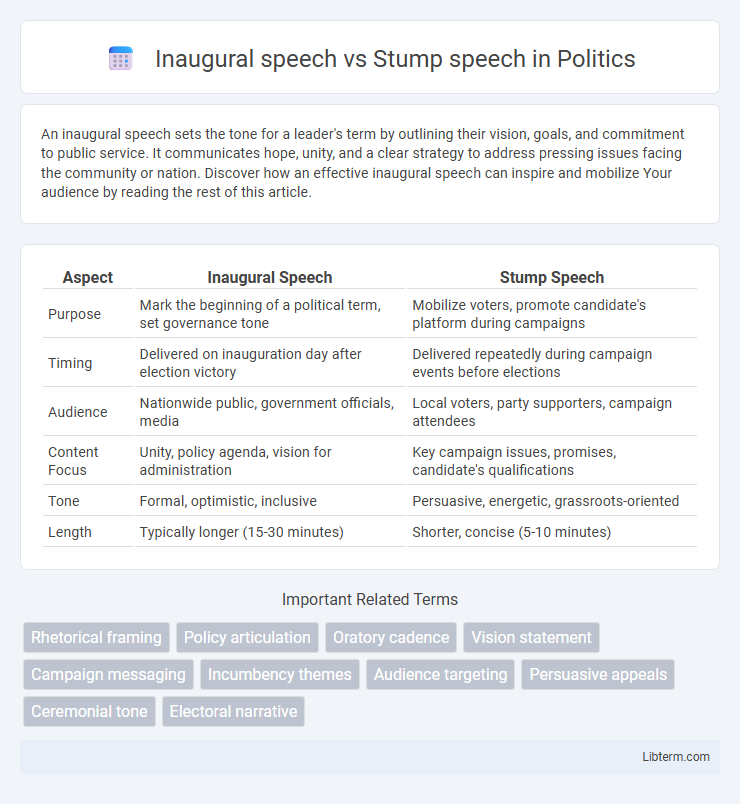An inaugural speech sets the tone for a leader's term by outlining their vision, goals, and commitment to public service. It communicates hope, unity, and a clear strategy to address pressing issues facing the community or nation. Discover how an effective inaugural speech can inspire and mobilize Your audience by reading the rest of this article.
Table of Comparison
| Aspect | Inaugural Speech | Stump Speech |
|---|---|---|
| Purpose | Mark the beginning of a political term, set governance tone | Mobilize voters, promote candidate's platform during campaigns |
| Timing | Delivered on inauguration day after election victory | Delivered repeatedly during campaign events before elections |
| Audience | Nationwide public, government officials, media | Local voters, party supporters, campaign attendees |
| Content Focus | Unity, policy agenda, vision for administration | Key campaign issues, promises, candidate's qualifications |
| Tone | Formal, optimistic, inclusive | Persuasive, energetic, grassroots-oriented |
| Length | Typically longer (15-30 minutes) | Shorter, concise (5-10 minutes) |
Defining Inaugural Speeches
Inaugural speeches mark the formal commencement of a leader's term, setting the administration's tone and outlining key policy goals. Defined by their ceremonial context, these speeches emphasize unity, national values, and vision for the future, distinguishing them from stump speeches that primarily aim to persuade and mobilize voters during campaigns. Inaugural addresses often become historic documents reflecting presidential priorities and guiding legislative agendas.
Understanding Stump Speeches
Stump speeches are concise, repetitive campaign messages designed to energize supporters and communicate key policy points clearly during political campaigns. Unlike inaugural speeches, which mark the beginning of an official term and outline broader governmental vision, stump speeches focus on persuasion and voter mobilization. Mastering the delivery and content of stump speeches is crucial for candidates aiming to connect with diverse audiences and secure electoral support.
Historical Origins: Inaugural vs. Stump Speeches
Inaugural speeches have their historical origins in formal ceremonies marking the commencement of a political leader's term, famously exemplified by George Washington's 1789 address that set a precedent for U.S. presidential inaugurations. Stump speeches trace back to 19th-century American political campaigns where candidates traveled rural circuits, delivering repetitive, rehearsed addresses atop tree stumps to engage voters directly. The inaugural speech symbolizes institutional authority and unity, while stump speeches embody grassroots campaigning and personalized voter persuasion.
Core Purpose and Audience
An inaugural speech serves as a formal address delivered by a newly elected official to outline their vision and priorities, aiming to inspire confidence among citizens and establish a governance agenda. A stump speech is a repetitive, persuasive presentation used by candidates during campaigns to connect with voters, emphasize key messages, and mobilize support. While the inaugural speech targets the entire nation or constituency with a unifying tone, the stump speech focuses on engaging diverse audiences at multiple events to secure votes.
Tone and Rhetorical Style Differences
Inaugural speeches typically feature a formal, unifying tone with polished rhetoric aimed at inspiring national unity and outlining a visionary agenda. Stump speeches employ a conversational, energetic tone designed to engage and persuade local audiences through repetitive messaging and emotional appeals. The rhetorical style of inaugural addresses emphasizes solemnity and statesmanship, while stump speeches rely on accessibility and direct voter connection.
Key Themes and Content Focus
Inaugural speeches emphasize unity, governance vision, and national priorities, aiming to inspire and outline a president's agenda for their term. Stump speeches concentrate on key campaign issues, voter concerns, and candidate qualifications, designed to persuade and mobilize support across various constituencies. Both types of speeches address leadership but differ in intent and audience engagement strategies.
Structure and Delivery Methods
Inaugural speeches adhere to a formal, structured format emphasizing unity, vision, and commitment, often delivered with measured pace and dignified tone to inspire trust and solemnity. Stump speeches feature a more flexible, repetitive structure designed for rallies, with energetic, conversational delivery aimed at engaging the audience and reinforcing key campaign messages. The inaugural speech relies on polished rhetoric and ceremonial presence, whereas stump speeches use colloquial language and dynamic gestures to connect directly with voters.
Influence on Public Perception
Inaugural speeches shape public perception by symbolizing leadership transition and setting a unifying, hopeful tone for the administration. Stump speeches influence public opinion through repetitive messaging tailored to rally support, emphasizing core campaign themes and voter engagement. The contrast lies in the inaugural's formality and broad appeal versus the stump's dynamic, persuasive approach designed to mobilize grassroots enthusiasm.
Notable Examples in Political History
Inaugural speeches such as John F. Kennedy's 1961 address are designed to outline a leader's vision and unify the nation at the start of a presidency, famously encapsulated by his line, "Ask not what your country can do for you." Stump speeches, exemplified by Barack Obama during his 2008 campaign, aim to persuade and mobilize voters by repeating key themes across multiple events. Both speech types play critical roles in political communication, with inaugural speeches marking transitions of power and stump speeches driving electoral momentum.
Lasting Impact on Political Discourse
Inaugural speeches serve as historical markers that outline a president's vision and set the tone for the administration, often becoming enduring national references for political values and unity. Stump speeches concentrate on immediate voter persuasion and rallying support, shaping campaign narratives and influencing electoral outcomes without necessarily leaving a long-term imprint on political discourse. The lasting impact of inaugural speeches is amplified by their ceremonial nature and wide dissemination, embedding key themes into the political culture over time.
Inaugural speech Infographic

 libterm.com
libterm.com